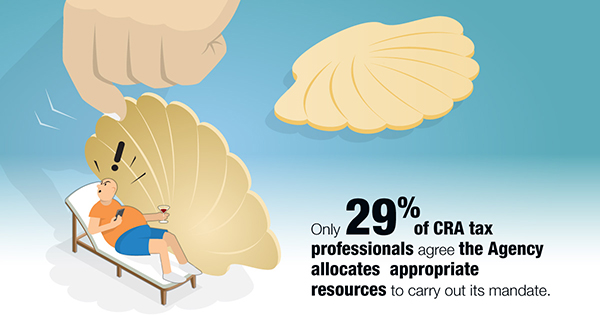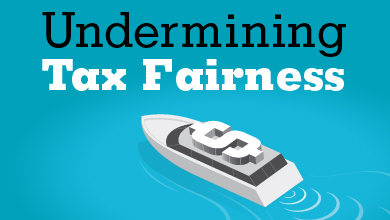Shell Game: How Offshore Havens, Loopholes, and Federal Cost-Cutting Undermine Tax Fairness, A Survey
2. The Resources
The mandate of the Canada Revenue Agency (CRA) is essential to the provision of public services that benefit all Canadians. But like all government operations, the fair, impartial collection of tax revenue can only be achieved if the funding and structures exist to support it. In our first report, we reviewed the current threats posed to tax fairness by aggressive tax avoidance schemes, such as off-shore tax havens, and the opinions of CRA tax professionals and Canadians about such threats. In the current report we focus on the resources required to ensure everyone pays their fair share of tax – and, more specifically, recent challenges in doing so.
The Agency’s professionals are trusted with the monumental task of assessing the operations of a $2-trillion economy and whether or not individuals and corporations pay their fair share of the $500 billion required to fund public services. Vital programs ranging from Old Age Security to food inspection and everything in between depend on it.
In February, 2018, the Professional Institute of the Public Service of Canada (PIPSC) conducted a survey of the entire population of professional staff at the CRA, including auditors, managers, forensic accountants, economists, statisticians, and actuaries. The purpose of the survey was to gather input on a variety of issues that affect the work lives of PIPSC members. However, the findings go far beyond the CRA workplace. These responses by thousands of tax professionals with special knowledge of the inner workings of the Canada Revenue Agency provide a unique opportunity to see how front-line employees interpret the impact of policy decisions in recent years.[1]
The Legacy of Cuts
While it is widely accepted that public services are good, determining the exact amount that should be spent on each program is a much harder task. The bulk of the responsibility for these decisions rests with elected officials. Starting in 2007, policy makers advanced an austerity agenda that targeted the federal public service. The initiative involved several waves of comprehensive spending reviews, accompanied by an extended budget and hiring freeze that began in 2010 and wasn’t lifted until 2016. The single most destructive event occurred as a result of the 2012 budget when, in one fell swoop, $250 million and 1,200 jobs were cut from CRA’s budget. All told, successive austerity initiatives resulted in almost $900 million in projected cuts and the scheduled elimination of almost 3,000 jobs[2].
Compliance, Voluntary Disclosure, Research, Technical Advisors and Special Enforcement were among the specific divisions targeted. Criminal Investigation was particularly hard hit. This division includes the law enforcement specialists tasked with identifying the most egregious cases of fraud and abuses of the tax code, and then working with the RCMP and prosecutors to ensure tax evaders with the means to defraud the system are held accountable. Before the cuts there was an investigative presence in 32 offices across the country. After the cuts, the headcount was reduced and the work consolidated within six “Centres of Expertise”, leaving, for example, a 3,000-kilometre gap between Toronto and Calgary within which no enforcement staff exist. The Auditor General recently criticized the CRA, noting that Canadians receive different treatment from the Agency depending on who they are and where they live.[3] This practice of centralizing operations for the sake of efficiency and trusting that it won’t have negative impacts is flawed and does not serve well Canadians who expect tax laws to be enforced equally across the country.
The CRA was not the only department harmed by cuts (the impacts were felt across the federal public service), but the CRA stands out as a key example of how supremely broken was the decision-making process that led to the cuts. The goal was flawed from the start. It included cutting for the sake of cutting, identifying massive reduction targets and compelling managers to slash and burn based on these arbitrary amounts. A more rational approach would have understood, either directly or indirectly, that professional employees at the CRA bring in revenue – with one Finance department estimate showing a $10 return for every $1 invested in combating international tax evasion and avoidance.[4] In other words, it would have recognized the value of preserving a fair tax system.
.jpg)
By contrast, Canadians and CRA professionals are in agreement on the value of preserving a fair tax system. When asked separately, for example, if it would be a “good investment” to “allocate more resources towards preventing tax evasion and avoidance” almost eight out of 10 Canadians (77%) and 84% of CRA tax professionals agreed.[5] Enforcement pays for itself and everyone benefits from the peace of mind that comes with knowing the rules are being applied fairly to everyone – especially to those trying hardest to get around them.
CRA tax professionals are predominantly accountants or officials who occupy positions requiring a high level of education in fields such as economics and public administration. Many hold supervisory positions. They care deeply about the efficient operation of the Agency and possess professional credentials that give their opinions credibility. Their views matter. Or at least they should matter.
When asked if “the internal restructuring that occurred after expenditure reviews in 2012 improved operations at CRA” only 6% agreed. In a related question, when asked if the restructuring “reflected the opinions of front-line CRA professionals” a mere 9% agreed.
Professional Integrity Concerns
In the wake of the cuts, some damning accusations have been levelled against the CRA. Critics and whistle blowers ascribe to organizational changes, intended to ensure lost capacity wouldn’t result in reduced revenue, a detrimental shift in the Agency’s focus. With significantly fewer auditors, the organization became more dependent on computer programs to make decisions about reviews, resulting in individuals, small businesses and charities facing increased scrutiny while big-time tax cheats, the ones with the means to aggressively avoid and evade their responsibilities, faced less scrutiny.
Whistleblowers have also noted a rise in lobbying efforts by corporations. It has even been suggested that, when audits of powerful corporations intensify, political pressure to resolve them has also increased.[6] This has led some employees at the CRA to feel that decisions to continue investigations or to pursue criminal charges are made based on the clout of the company being audited as opposed to the merits of the case itself. As noted in our previous report, 45% of tax professionals agreed that CRA’s mandate has been compromised by “political interference.” While the term itself was not defined, the response highlights a worrying perception that warrants further investigation.
Given this context, whistleblower protection is crucial. CRA officials are frequently put in precarious situations where they’re asked to hold powerful players to account in high-stakes settings. Whistleblower protection is crucial to ensuring professional integrity is paramount during the tax assessment process.
Asked if they trust the Canada Revenue Agency's whistleblower protection policies when it comes to reporting illegal or unethical practices, only 30% agreed. In other words, 70% either disagreed or were unsure about the extent to which they would be protected if it came to facing such ethical dilemmas. Auditors are often caught between powerful institutional actors. As they carry out these challenging responsibilities, they need to know that if they take a principled stance they will be protected without fear of reprisal.
The Funding Gap
Most of the problems highlighted in this report are rooted in misguided and poorly executed cuts by the former government. Since 2015, the Trudeau government has made investments that represent meaningful steps towards a fairer tax system. Budgets 2016 and 2017 made combined commitments that averaged approximately $200 million per year in worthwhile initiatives to curb evasion and aggressive tax avoidance. While these steps are welcome, it’s impossible to consider their impact without reference to the scale of the cuts that occurred under the Harper government. Spending is only now being restored to pre-2012 levels. Meanwhile the population has grown, the amount of commerce has increased and the complexity of tax evasion schemes continues to advance. The status quo is not enough. When adjusted for inflation, a $500-million gap exists between 2012 and today.
In our first report, we noted that CRA tax professionals frequently feel outgunned, and that almost 80% believe training and technology at the CRA have not kept pace with the complexity of tax avoidance schemes. They also feel audit coverage isn’t consistent, with only 16% of respondents believing tax laws are being applied fairly across the country. The investments made in recent years have been well received but the impact has not been felt equally across the organization.

When asked how they would characterize the changes in capacity since October 2015, almost two-thirds (64%) of respondents said that capacity is the same or has decreased. When asked if their department allocates appropriate resources to successfully carry out CRA's mandate, only 29% agreed. This is a stark reminder of the depth and systemic harm of past cuts.
CRA Renewal
As in our previous report, PIPSC proposes several practical steps be taken in response to the problems noted in this report. We believe the government should immediately invest additional, annual, ongoing funding to the CRA in the following areas:
Hire 200 Technical Advisors: The Technical Advisor position was all but eliminated after the cuts in 2012. These positions included subject matter experts who assisted audit teams on a wide variety of issues. During the consolidation exercise, many of these positions were either cut or merged with supervisory roles. The end result is that audit teams have been disadvantaged by the loss of a key position that once helped level the playing field between the CRA and big-time tax cheats.
Invest in technology and training: Auditors often feel they are trying to combat cutting-edge innovations in tax avoidance with decades-old technology. The productivity (read revenue) gains to be derived from phasing out and replacing obsolete technology systems would more than pay for the initial investment. Moreover, investment in new skills development opportunities would significantly renew training lost in previous budget cuts.
Enhance capacity in regional offices: The Auditor General has found that taxpayers receive different treatment from the CRA depending on where they live and who they are. We believe that Harper-era cuts and the resulting consolidation of services have significantly contributed to this finding. There needs to be a Criminal Investigation presence across the country and all regional offices need the appropriate resources to ensure laws are applied fairly from coast to coast.
Strengthen whistleblower protections: Whistleblower protection is an important safeguard that maintains the tax system’s integrity by protecting those who bring attention to illegal or unethical behaviour. In 2016, the House Standing Committee on Government Operations and Estimates held hearings to review the Public Servants Disclosure Protection Act and produced a list of recommendations that includes:
- better education,
- more standardized practices across the federal government,
- enhanced confidentiality, and
- better tools to prevent retaliation.
It is imperative that these recommendations be implemented immediately.
[1] Invitations to complete the Professional Integrity, Workplace Satisfaction and Tax Fairness Survey were sent to 11,599 members of the Audit, Financial and Scientific Group (AFS) at the Canada Revenue Agency between February 20 and March 6,2018. Of those who were invited, 2,170 respondents completed the survey (18.7%).
[2] 2013-2014 Canada Revenue Agency Report on Plans and Priorities
[3] 2018 Fall Reports of the Auditor General – Compliance Activities – Canada Revenue Agency
[4] What is Wrong at the CRA? And How to Fix It, Canadians for Tax Fairness, December 2015, p. 15
[5] The public opinion survey by Environics Research (commissioned by PIPSC) was conducted by telephone among 1,000 Canadians between July 3 and 8, 2018. The results can be considered accurate + or – 3.2%, 19 times out of 20.
[6] What is Wrong at the CRA? And How to Fix It, Canadians for Tax Fairness, December 2015, p. 20



